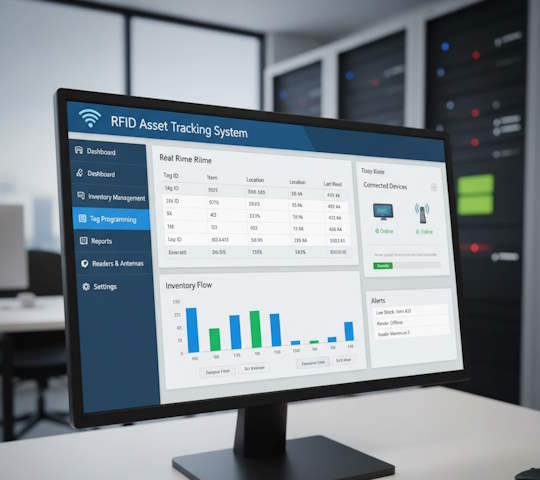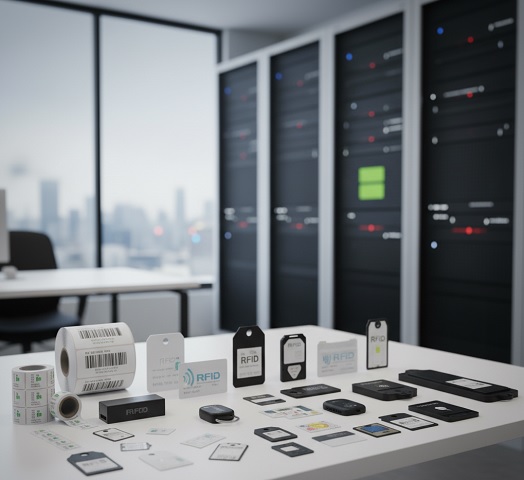Implementing RFID in the Coal Industry: Systems for Mines and Pits
Technology Foundations: RFID Built for Harsh Mining Conditions
Mining operations expose systems to dust, moisture, vibration, metal interference, and extreme temperatures. Specialized RFID solutions address these challenges.
Environmental Challenges for RFID in Mining
-
Dust and humidity up to 95%
-
Constant vibration and heavy mechanical stress
-
Exposure to aggressive chemicals
-
Signal interference from large metallic surfaces
-
Temperature fluctuations from –40°C to +85°C
Anti-Metal UHF Tags
-
Ferrite substrate to counteract metal interference
-
Isolation layer enables stable reading up to 8 m
-
PPS housing with IP68 protection
-
Chemical resistance against acids, alkalis, solvents
Industrial-Grade Readers
| Device Type | Operating Temp. | Reading Range | Protection |
|---|---|---|---|
| Fixed | –40°C to +85°C | up to 12 m | IP67 |
| Mobile | –20°C to +60°C | up to 5 m | IP65 |
Integration features:
-
Protocols: Modbus, Profibus, Ethernet/IP
-
Direct connection to ERP and SCADA
-
Full compliance with EPCglobal UHF Class 1 Gen 2 (ISO/IEC 18000-63)
Core Applications of RFID in Coal Mining
1. Equipment & Fleet Management
Coal mines manage thousands of high-value assets worth $50,000 to $2M each.
Automated Asset Tracking
-
5–7× faster inventory checks
-
99.9% accuracy vs. manual records
-
Elimination of human error
-
Real-time database updates
Predictive Maintenance
RFID-enabled digital equipment passports include:
-
Repair & replacement history
-
Runtime in engine hours
-
Scheduled maintenance deadlines
-
Predictive failure alerts
Business outcome: Downtime reduced by 35–45%.
2. Enhancing Worker Safety
Worker protection is mission-critical in mining.
Access Control & Worker Tracking
RFID-enabled ID badges provide:
-
Accurate worker identification
-
Controlled access to restricted areas
-
Emergency roll calls underground
-
Time-on-site monitoring
PPE (Personal Protective Equipment) Tracking
| PPE Item | RFID Tag Type | Tracked Parameters |
|---|---|---|
| Helmets | Embedded | Service life, integrity |
| Flame-retardant suits | Sewn-in | Wear, chemical exposure |
| Respirators | Detachable | Filters, calibration |
| Safety boots | Embedded | Sole condition, steel inserts |
Result: PPE-related safety incidents cut by 25% in EU pilots.
Worker & Vehicle Movement Monitoring
-
Entry/exit time logging
-
Route tracking for vehicles
-
Overspeed alerts underground
-
Unauthorized zone access detection
3. Logistics Optimization & Coal Transport
Transport costs account for 15–20% of total mining expenses.
Underground Railcar Tracking
RFID automates:
-
Railcar-level asset management
-
Cargo weight measurement (via integration with scales)
-
Shift-level production reporting
-
Route optimization for mine haulage
Surface Vehicle Management
-
Automated vehicle ID at gates
-
40–60% reduction in wait times
-
Zero manual entry errors
-
Integration with weighing systems
Case Study: Dazhong Mining (China)
Deployment Scale:
-
3,500+ assets tagged
-
450 employees with RFID cards
-
12 mine areas equipped with readers
-
Investment: $280,000
Key Results:
| Metric | Before | After | Improvement |
|---|---|---|---|
| Inventory time | 120 h | 60 h | –50% |
| Data accuracy | 85% | 99.9% | +17% |
| Asset search time | 45 min | 5 min | –89% |
| Downtime per month | 35 h | 22 h | –37% |
ROI: Payback in 18 months.
Business Value of RFID in Coal Mining
Quantitative Gains
-
Inventory speed: +40–60%
-
Accuracy: +15–20%
-
Asset search time: –90%
-
Lost equipment: –25–30%
Cost Savings:
-
Unplanned repairs: –30–40%
-
Spare parts stock: –15–20%
-
Labor for asset management: –50–65%
-
Insurance payouts: –20–25%
Qualitative Benefits
-
Stronger compliance with safety regulations
-
Improved safety culture among workers
-
Real-time operational data
-
Automated regulatory reporting
Investment Model: TCO & ROI
Typical mid-sized mine project:
| Component | Cost | Share |
|---|---|---|
| RFID tags (5,000 units) | $15,000 | 25% |
| Readers (50 units) | $25,000 | 42% |
| Software & integration | $12,000 | 20% |
| Deployment & training | $8,000 | 13% |
| Total | $60,000 | 100% |
Annual OPEX: $8,000–12,000
Typical savings: $45,000–65,000/year
Frequently Asked Questions (FAQ)
Q1: What’s the read range of RFID tags in mines?
Up to 8 m on metal surfaces, 12 m with high-power fixed readers.
Q2: Can RFID operate in explosive environments?
Yes, ATEX- and IECEx-certified explosion-proof RFID systems are available.
Q3: How long does implementation take?
End-to-end rollout: 3–4 months (design → installation → training).
Q4: What IT infrastructure is needed?
-
Industrial Ethernet (≥10 Mbps)
-
Database server (Windows/Linux)
-
UPS for critical nodes
-
Wi-Fi coverage for handhelds
Q5: How is data security ensured?
-
AES-256 encryption
-
Active Directory authentication
-
Network segmentation
-
Backup with ≤4 h RPO
Q6: How durable are the tags?
Industrial RFID tags last 10–15 years under mining conditions.
Q7: What’s the scalability limit?
Modern systems support 100,000+ tags, reading 200 tags/sec per reader.
Conclusion & Next Steps
RFID is no longer optional—it’s a strategic enabler for safe, efficient, and competitive coal mining.
Key Benefits:
-
+40–60% operational efficiency
-
–25% safety incidents
-
–15–20% operating costs
-
ROI in 12–24 months
Action Plan for Mining Companies:
-
Conduct an asset management audit
-
Define high-priority areas for pilot projects
-
Choose a technology partner with mining expertise
-
Plan phased deployment
-
Train personnel for digital adoption




